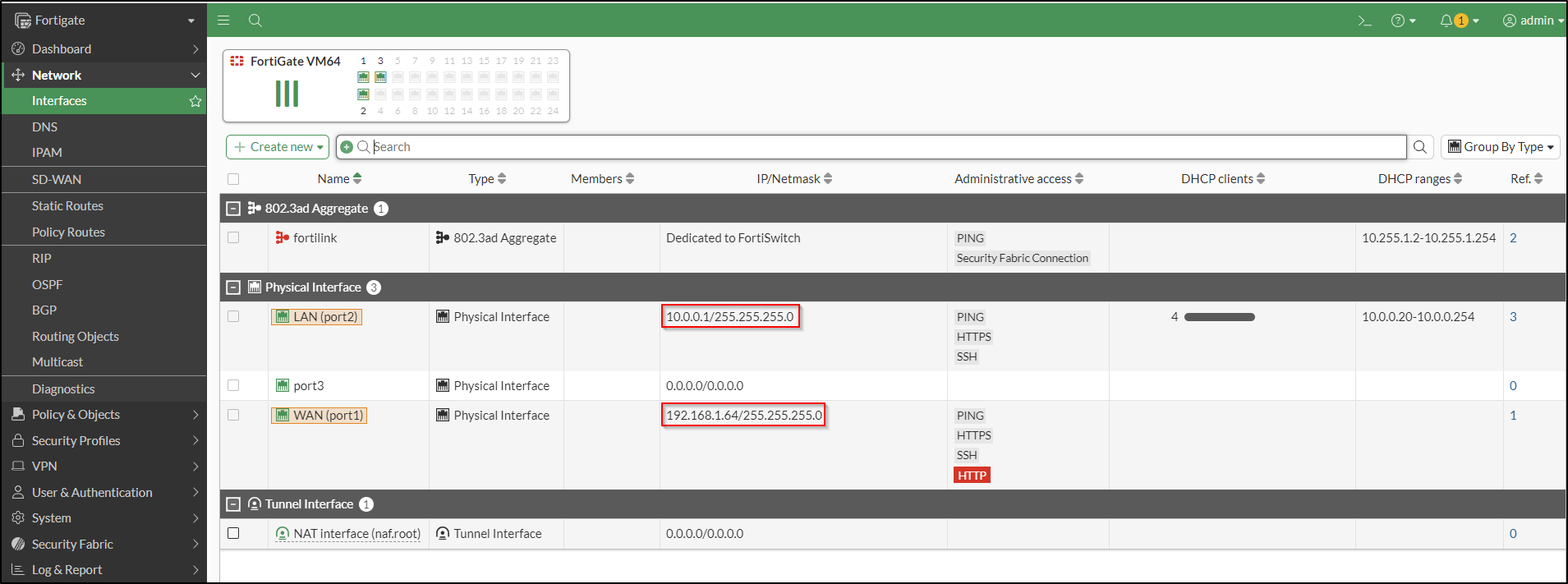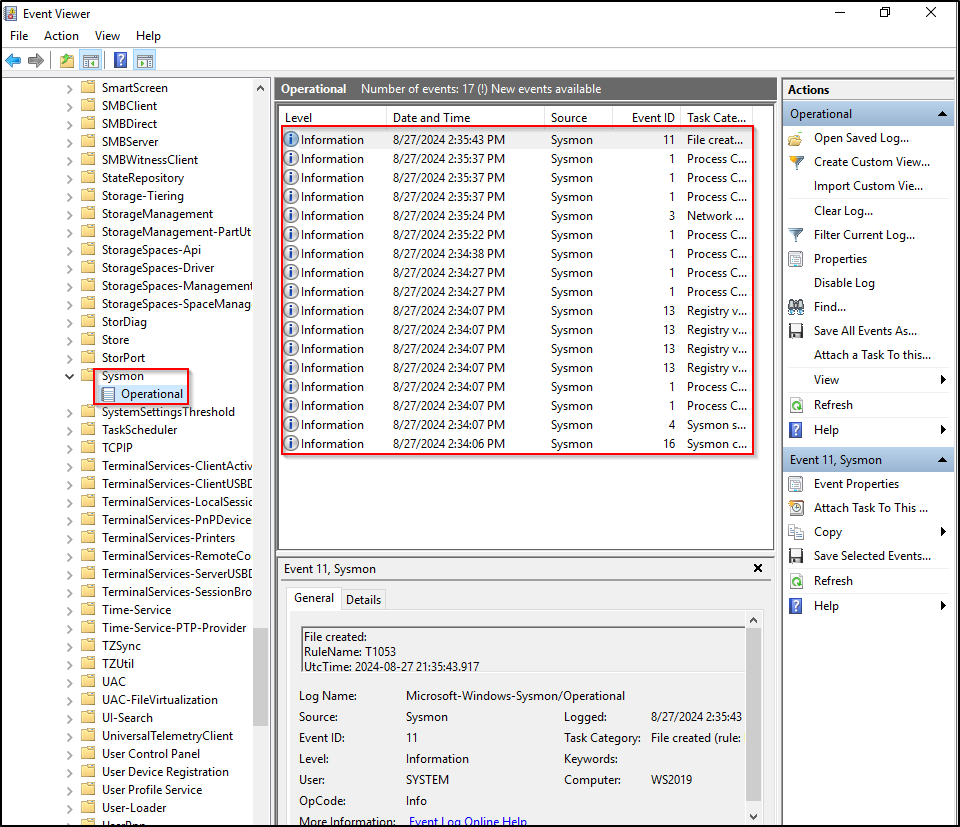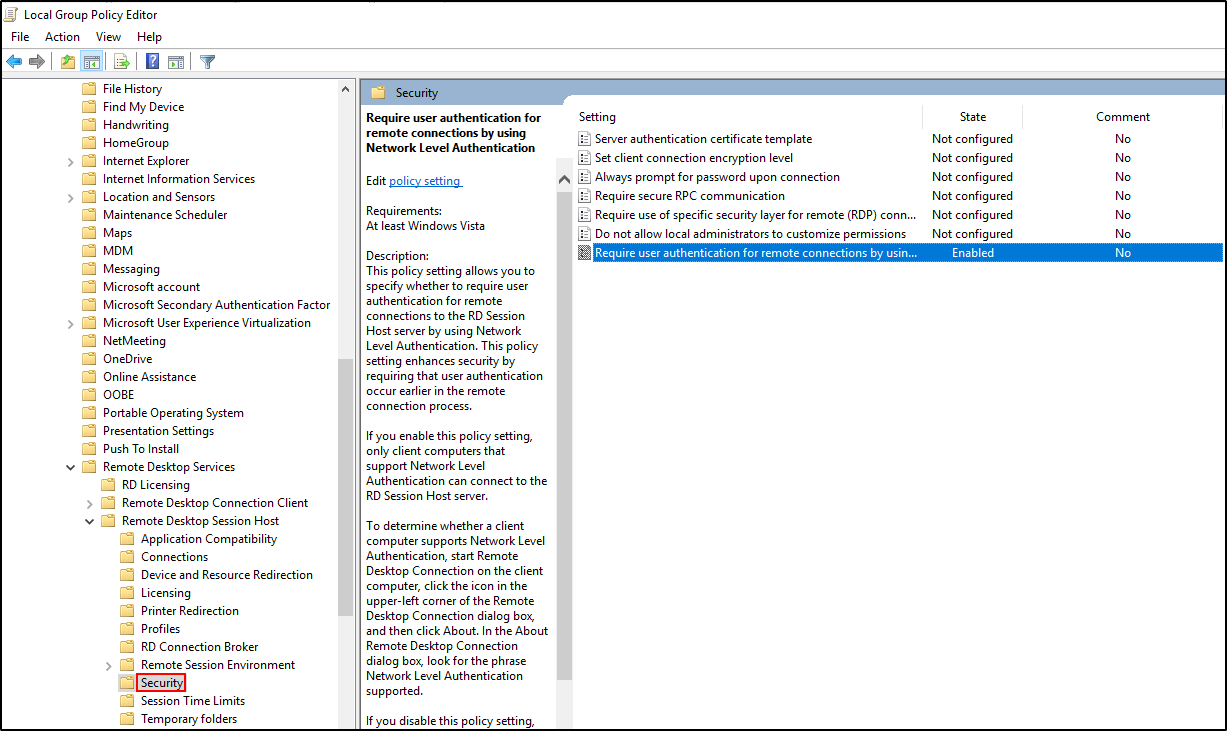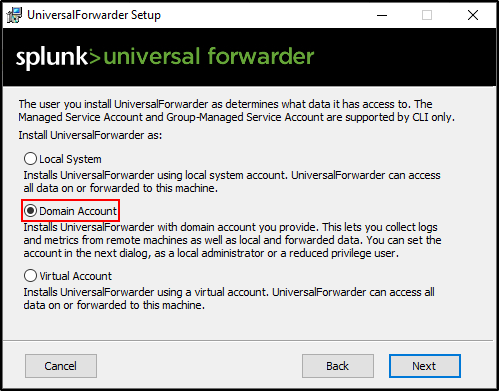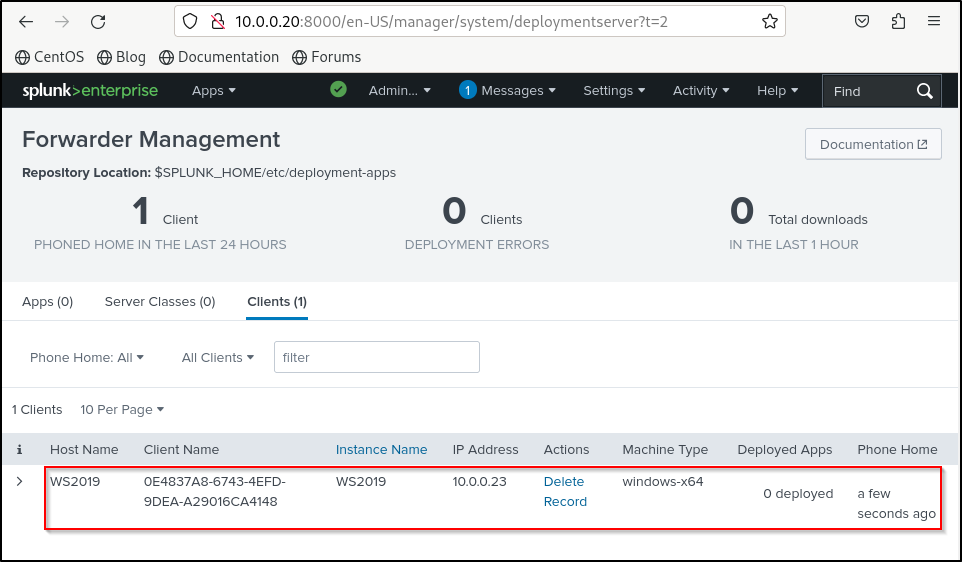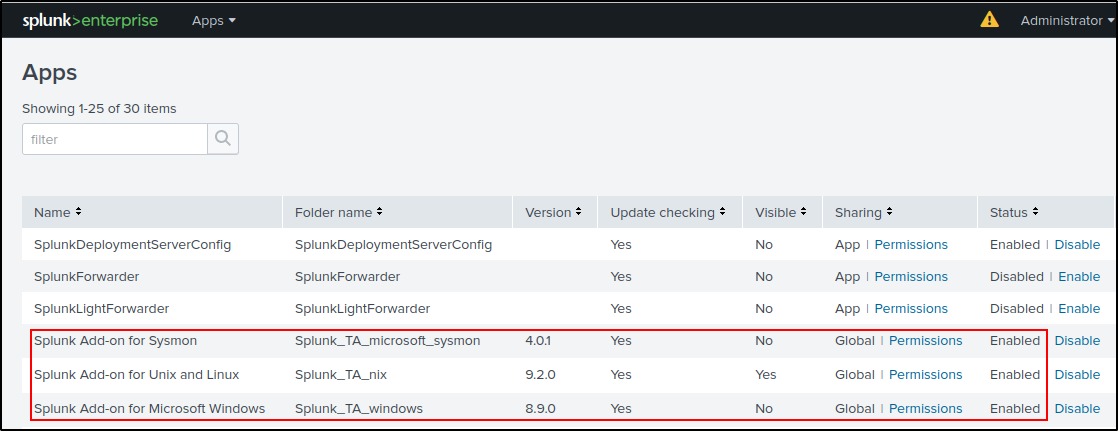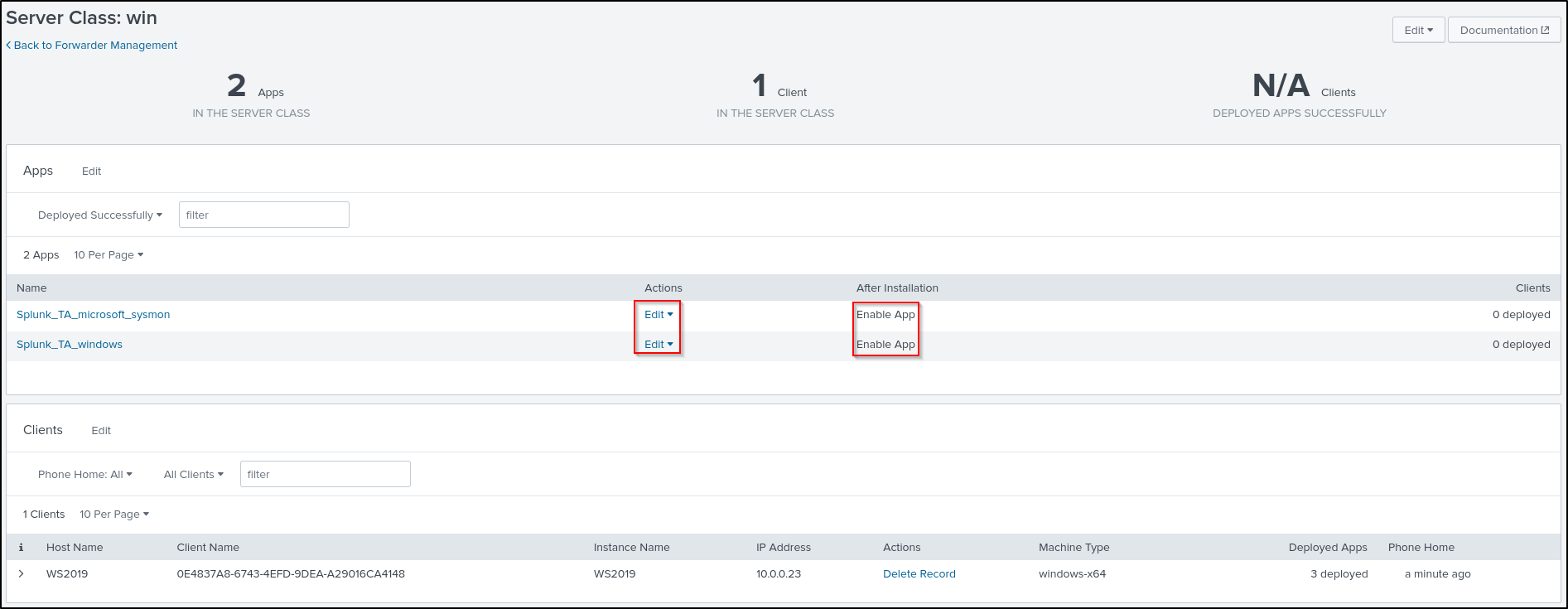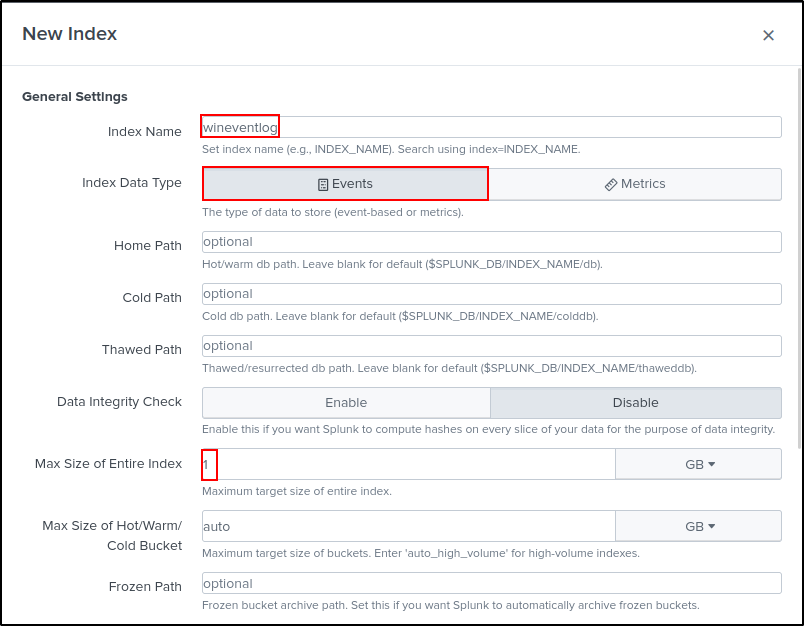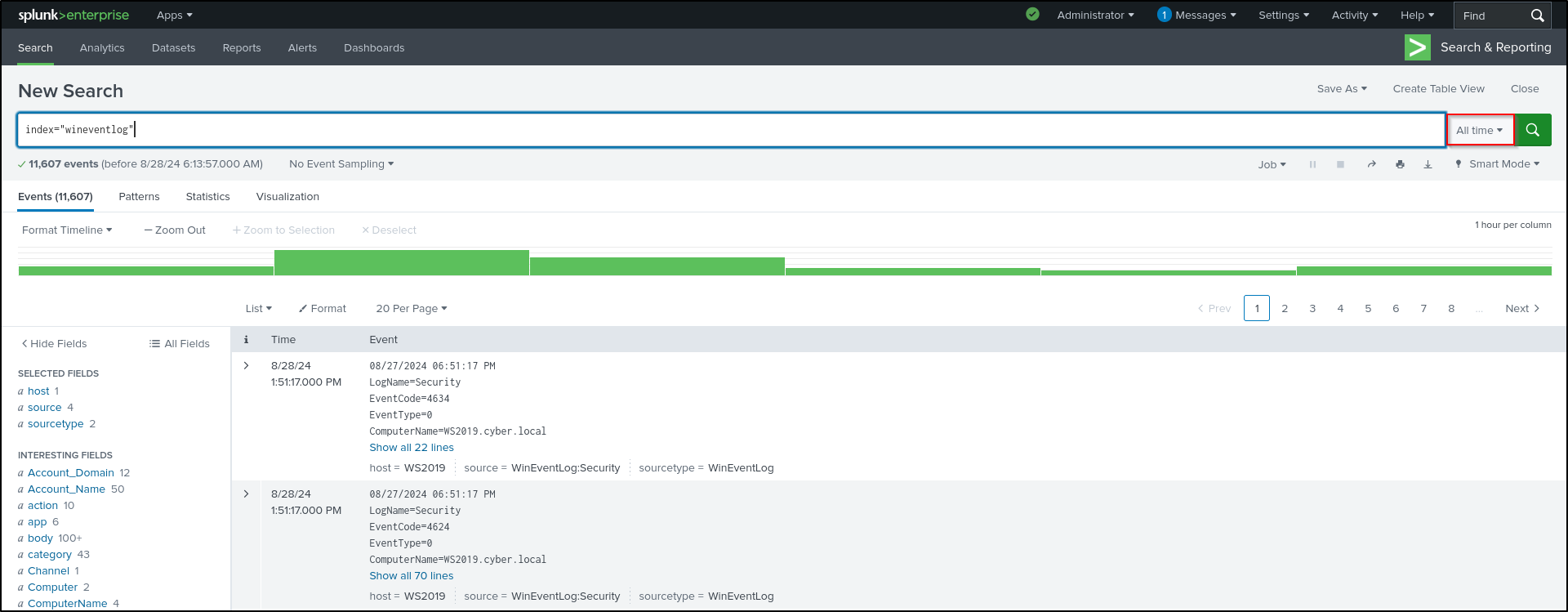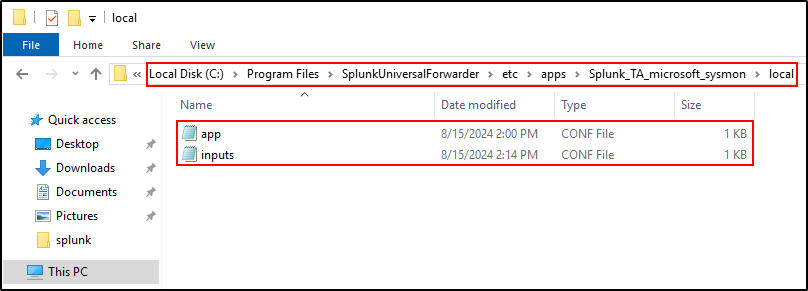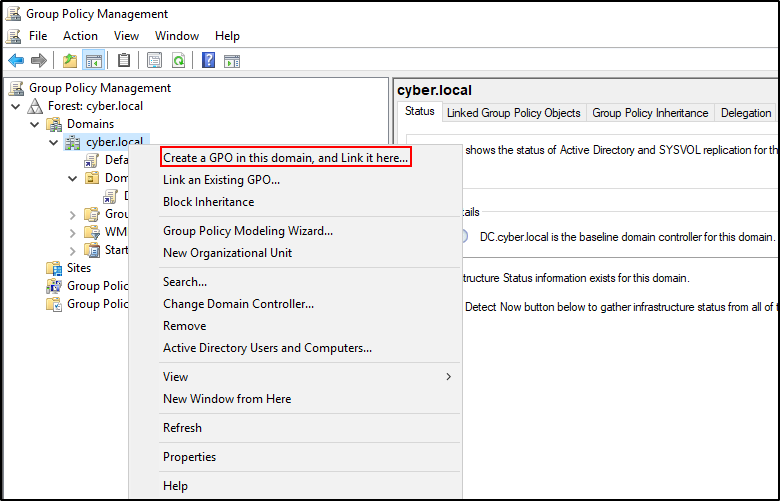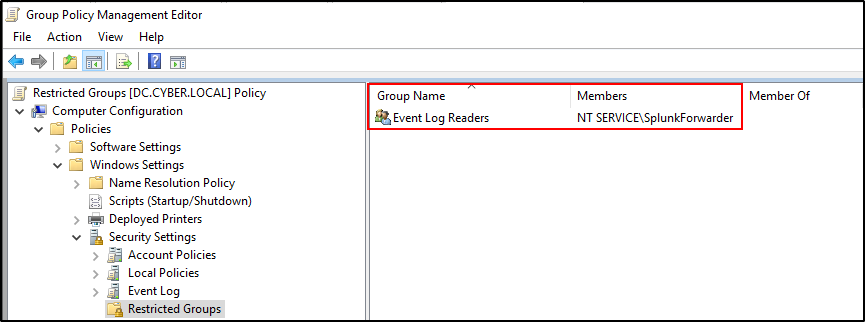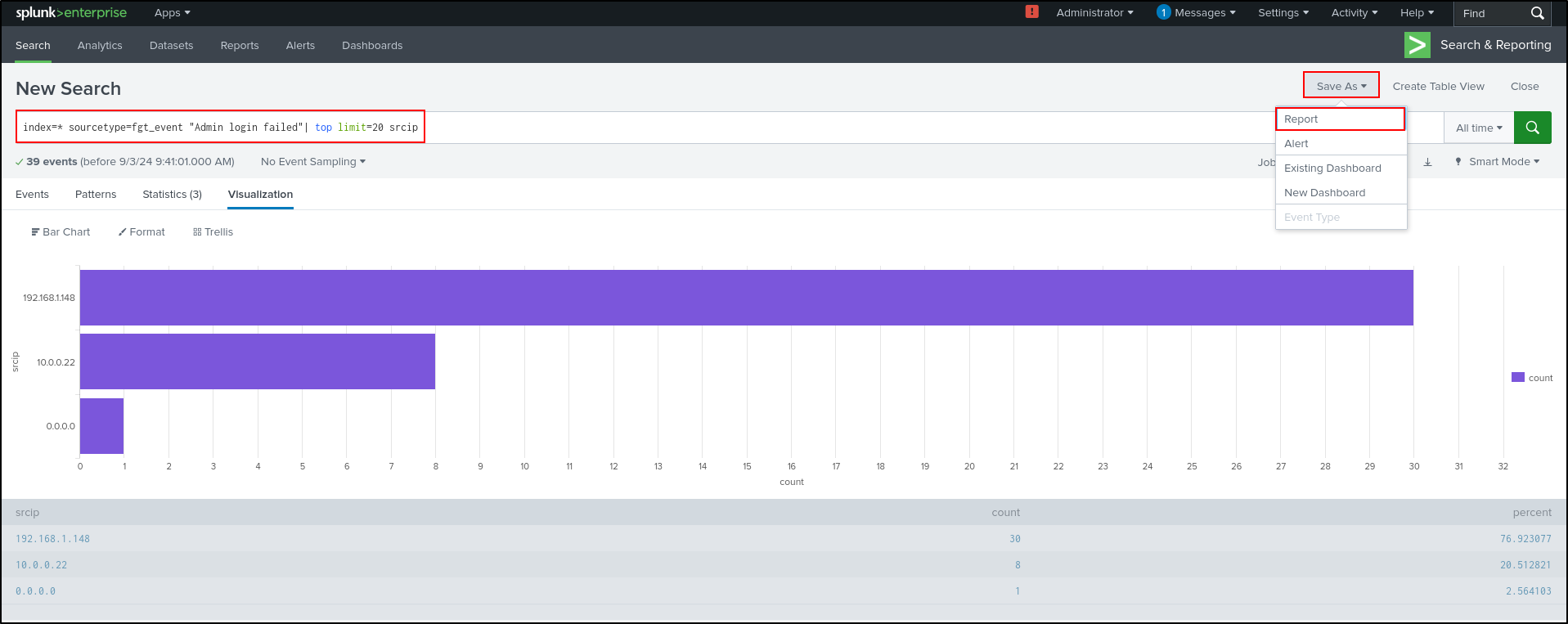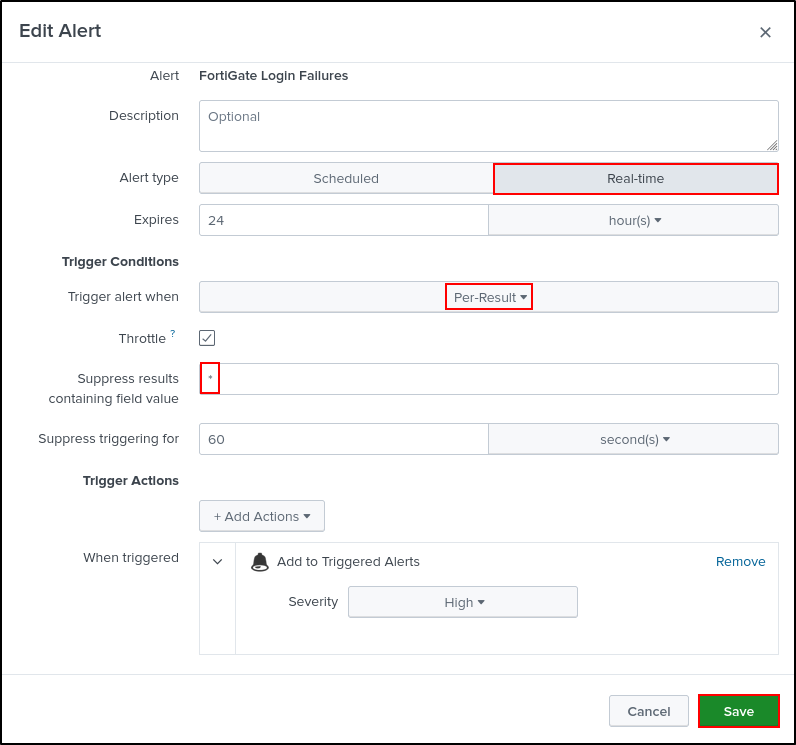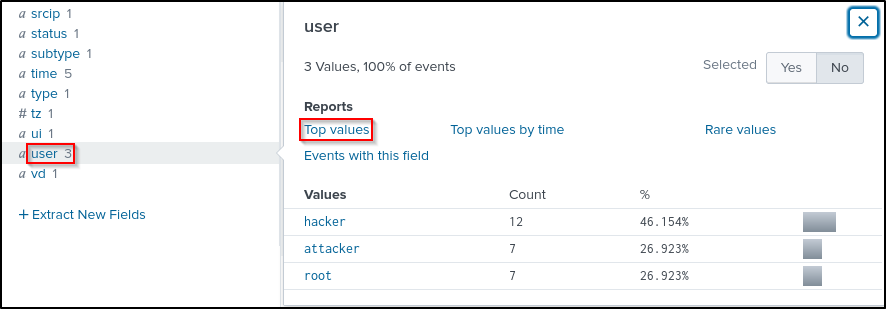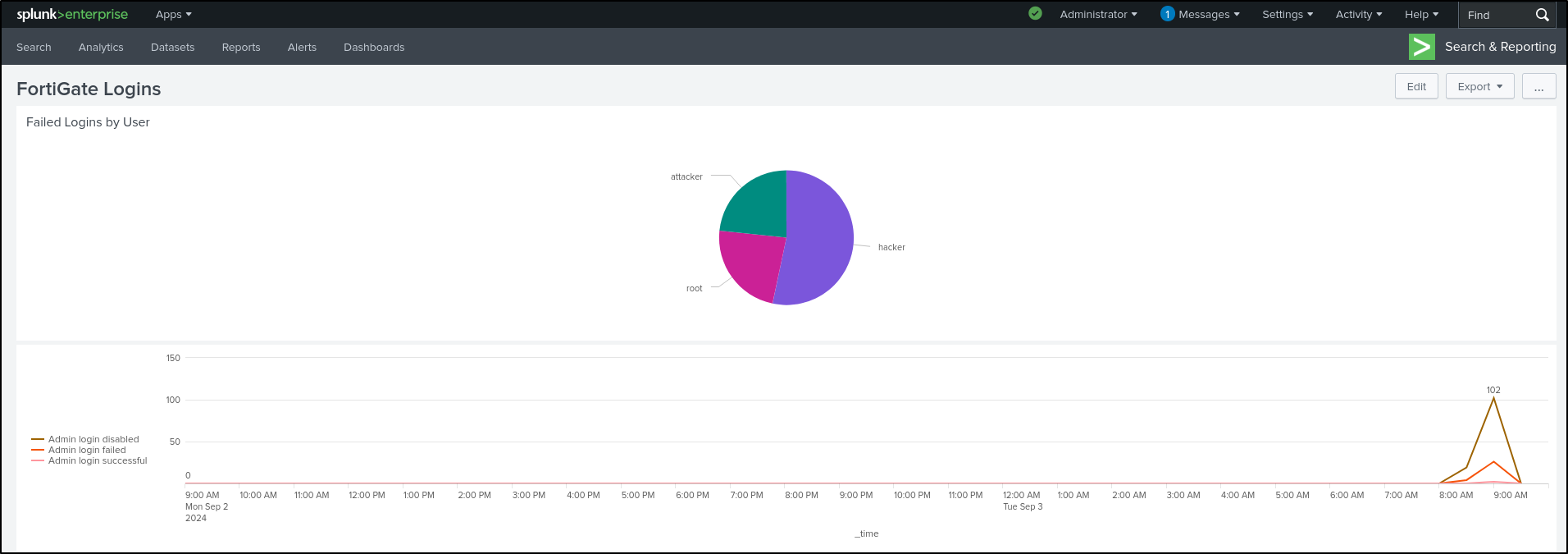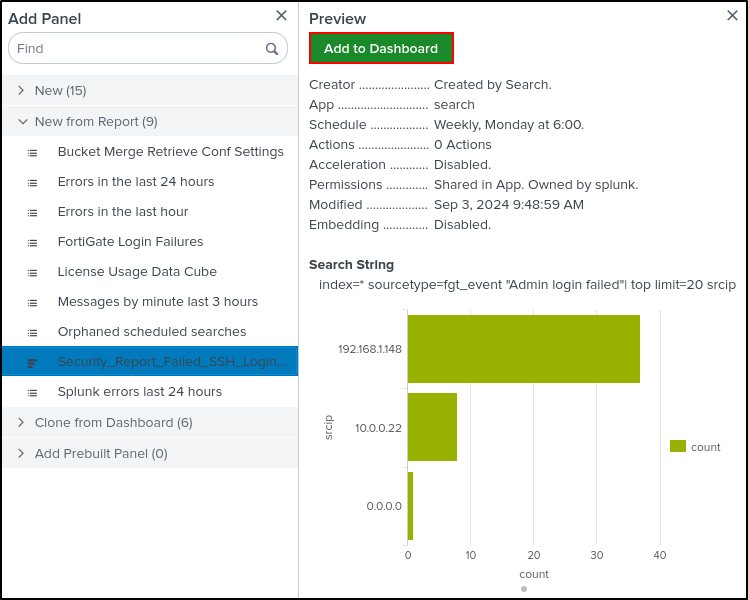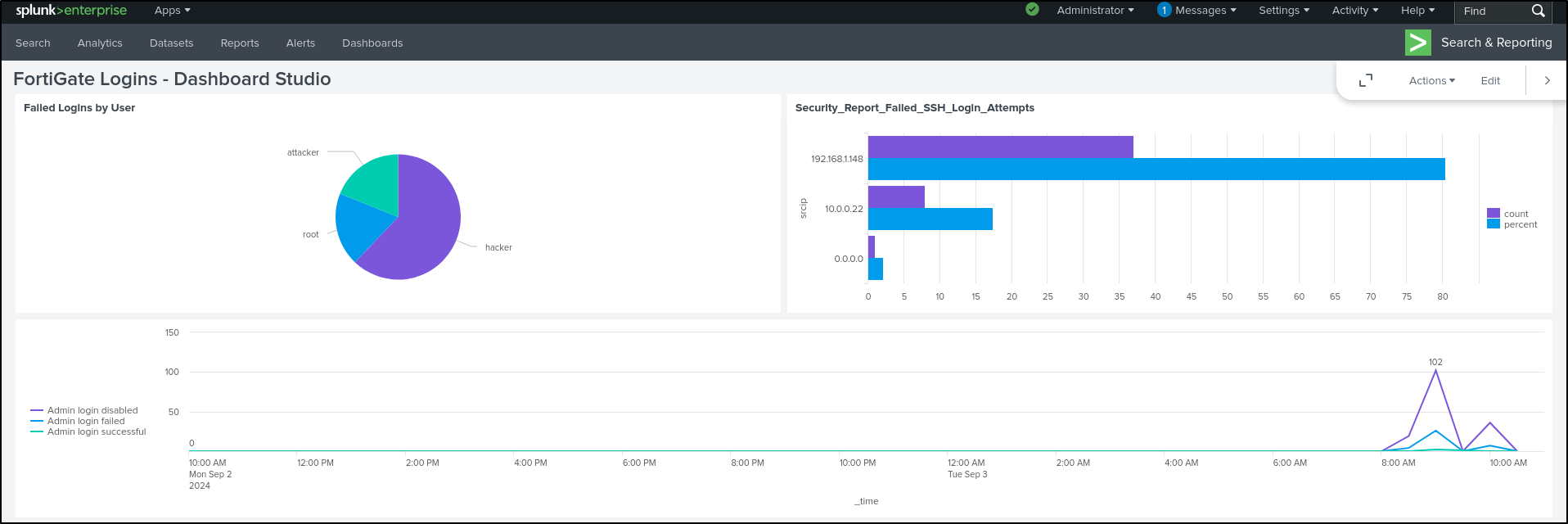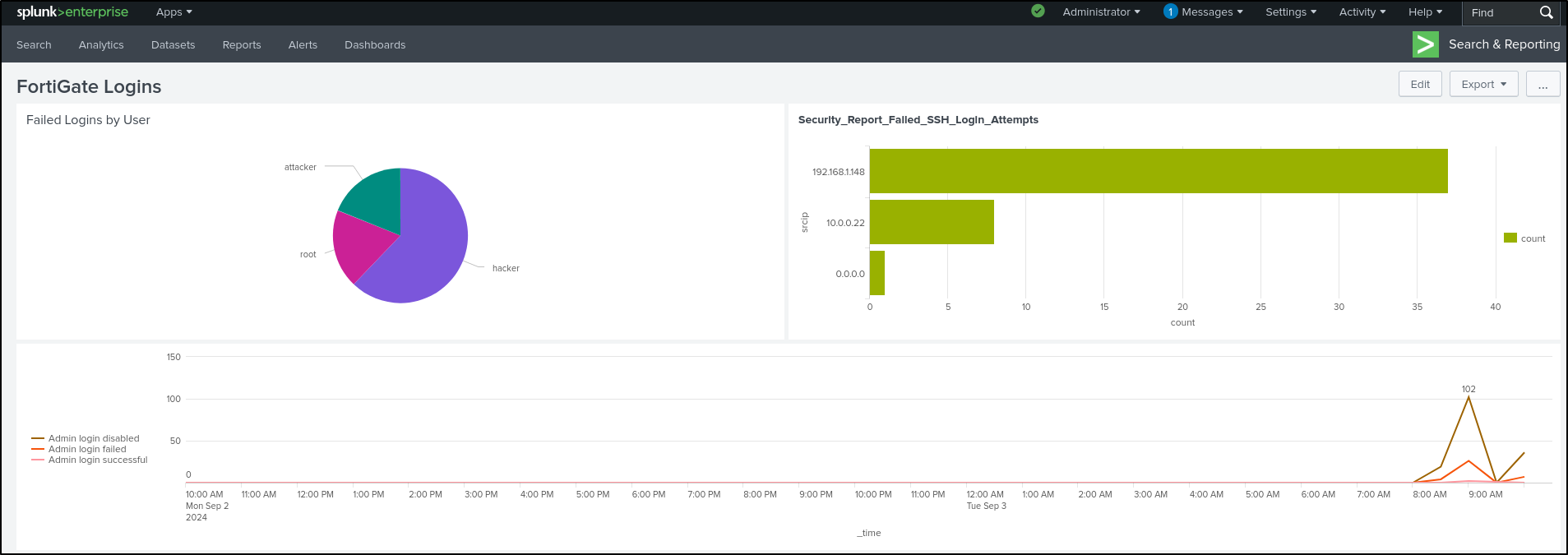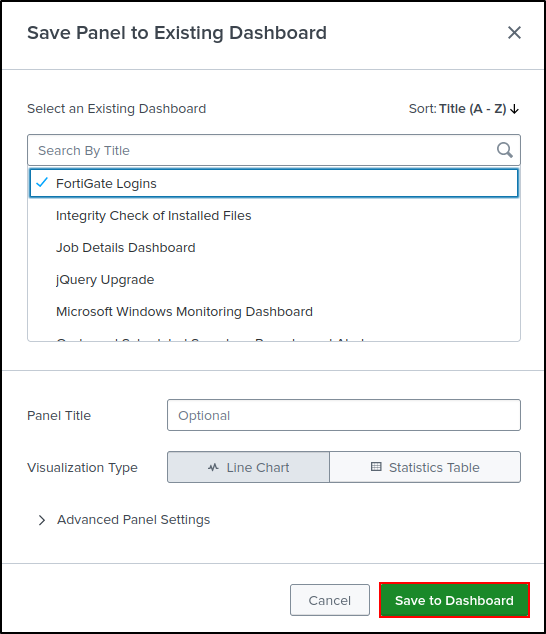Splunk
Splunk Enterprise is a Security Information and Event Management (SIEM) tool usually installed on the server. It is designed for searching, analysing, and visualising data. It allows users to collect and ingest data, and search across various data types. Splunk Universal Forwarders are usually installed on clients to provide reliable, secure data collection and forward that data into Splunk Enterprise for indexing. This part of documentation focuses on installing and configuring Splunk. For Splunk, the main focus will be installing Splunk Enterprise and Universal Forwarder.
Lab Setup for Proof of Concept
In this proof of concept, Splunk Enterprise was installed on an Ubuntu VM (Virtual Machine), and the Splunk Universal Forwarder was installed on both Ubuntu and Windows VMs. An attack emulation was conducted on the FortiGate VM in a safe and controlled environment.
Note: Do not attempt to replicate the attack emulation demonstrated here unless you are properly trained and it is safe to do so. Unauthorised attack emulation can lead to legal consequences and unintended damage to systems. Always ensure that such activities are conducted by qualified professionals in a secure, isolated environment.
For Documentation:
| Hostname | OS | Role | IP Address |
|---|---|---|---|
| Fortigate | Fortios 7.6.0 | Firewall/Router | 192.168.1.10 (WAN) / |
| 10.0.0.1 (LAN) | |||
| Splunk | Ubuntu 24.04 | Splunk Enterprise (server), SC4S | 10.0.0.100 |
| Ubuntu | Ubuntu 24.04 | Splunk Universal Forwarder (Linux client) | 10.0.0.200 |
| WS2019 | Windows Server 2019 | Splunk Universal Forwarder (Windows client) | 10.0.0.50 |
| Kali | Kali Linux 2025.1 | Attacker machine | 10.0.0.22 |
Installing Splunk Enterprise Offline
This documentation explains how to install Splunk Enterprise offline on Ubuntu or CentOS virtual machines (VMs).
On an Internet-Connected Machine (Ubuntu)
On an internet-connected Ubuntu VM, refresh the package lists from the repositories and create a structured directory for downloading dependencies:
Download and install VM tools and its dependencies (this will enable copy and pasting and dynamic resolution). After installing VM tools, reboot the VM.
cd ~/splunk-offline/vmtools
apt-get download \
libatkmm-1.6-1v5 \
libcairomm-1.0-1v5 \
libglibmm-2.4-1t64 \
libgtkmm-3.0-1t64 \
libmspack0t64 \
libpangomm-1.4-1v5 \
libsigc++-2.0-0v5 \
libxmlsec1t64 \
libxmlsec1t64-openssl \
open-vm-tools \
open-vm-tools-desktop \
zerofree
sudo dpkg -i *.deb
Register on the Splunk website for a free trial and download Splunk Enterprise for Linux. There are options for .tgz, .deb, and .rpm. Use wget and copy and paste the wget link in the splunk-offline directory.
cd ~/splunk-offline
wget -O splunk-9.4.1-linux-amd64.tgz "https://download.splunk.com/products/splunk/releases/9.4.1/linux/splunk-9.4.1-<SNIP>-linux-amd64.tgz"
Download Docker Engine and its dependencies. If you are using CentOS, skip this step as Podman is already installed.
#Ubuntu 22.04
cd ~/splunk-offline/docker
wget https://download.docker.com/linux/ubuntu/dists/jammy/pool/stable/amd64/containerd.io_1.7.25-1_amd64.deb
wget https://download.docker.com/linux/ubuntu/dists/jammy/pool/stable/amd64/docker-ce_28.0.0-1~ubuntu.22.04~jammy_amd64.deb
wget https://download.docker.com/linux/ubuntu/dists/jammy/pool/stable/amd64/docker-ce-cli_28.0.0-1~ubuntu.22.04~jammy_amd64.deb
wget https://download.docker.com/linux/ubuntu/dists/jammy/pool/stable/amd64/docker-buildx-plugin_0.21.0-1~ubuntu.22.04~jammy_amd64.deb
wget https://download.docker.com/linux/ubuntu/dists/jammy/pool/stable/amd64/docker-compose-plugin_2.33.0-1~ubuntu.22.04~jammy_amd64.deb
#Ubuntu 24.04
cd ~/splunk-offline/docker
wget https://download.docker.com/linux/ubuntu/dists/noble/pool/stable/amd64/containerd.io_1.7.25-1_amd64.deb
wget https://download.docker.com/linux/ubuntu/dists/noble/pool/stable/amd64/docker-ce_28.0.0-1~ubuntu.24.04~noble_amd64.deb
wget https://download.docker.com/linux/ubuntu/dists/noble/pool/stable/amd64/docker-ce-cli_28.0.0-1~ubuntu.24.04~noble_amd64.deb
wget https://download.docker.com/linux/ubuntu/dists/noble/pool/stable/amd64/docker-buildx-plugin_0.21.0-1~ubuntu.24.04~noble_amd64.deb
wget https://download.docker.com/linux/ubuntu/dists/noble/pool/stable/amd64/docker-compose-plugin_2.33.0-1~ubuntu.24.04~noble_amd64.deb
Download net-tools.
Download the latest SC4S container image oci_container.tgz from SC4S GitHub page.
cd ~/splunk-offline/sc4s
wget https://github.com/splunk/splunk-connect-for-syslog/releases/download/v3.34.3/oci_container.tar.gz
Download the following Splunk Apps (tar archive files). You will need to login using the registered credential.
- Splunk Add-on for MS Windows
- Splunk Add-on for Sysmon
- Fortinet FortiGate Add-On for Splunk (optional: required if ingesting FortiGate logs through this App)
- Splunk Add-on for Unix and Linux
Copy the Splunk Apps to ~/splunk-offline/apps/ directory. Verify that the apps have been copied.
Compress all dependencies with sudo privileges before transferring them. This process may take some time.
Change the ownership of splunk-offline.tar.gz to your standard user and group, then verify the change.
Transfer splunk-offline.tar.gz to the air-gapped Ubuntu VM using a USB drive.
On the Air-Gapped Environment
On the air-gapped VM, make a directory called splunk-offline and extract the transferred archive. This process may take some time.
Install VM tools and its dependencies (this will enable copy and pasting and dynamic resolution). After installing VM tools, reboot the VM.
Install Docker and its dependencies. Verify Installation.
Run sudo service docker start
Run the following command to add your user to the docker group:
Reload the group membership for your current session with the following command:
Check if you can run Docker commands without sudo:
Install net-tools and verify installation.
In a new tab as the standard user, set the host OS kernel to match the default receiver buffer of SC4S, which is set to 16MB. Add the following content to /etc/sysctl.conf:
Apply to the kernel by running the command sysctl -p
Ensure the kernel is not dropping packets. Please note that you may see some packet receive errors due to the air-gapped environment. These errors can be ignored.
Extract the splunk-offline tar archive to the /opt directory.
Create user splunk and change ownership of /opt/splunk directory to the splunk user. Enter password and user information for the splunk user (use default values by pressing enter ).
If you are using CentOS, after adding user, go to settings > Users. Unlock to Change Settings. Set password for the splunk user. Make the splunk user the owner of the /opt/splunk directory and verify the ownership.
#Example output
total 12
drwxr-xr-x 3 root root 4096 Sep 18 15:36 .
drwxr-xr-x 20 root root 4096 Sep 18 15:21 ..
drwxr-xr-x 11 **splunk splunk** 4096 Sep 6 05:58 splunk
Switch to splunk user and start Splunk Enterprise. When prompted, create admin credentials.
This appears to be your first time running this version of Splunk.
Splunk software must create an administrator account during startup. Otherwise, you cannot log in.
Create credentials for the administrator account.
Characters do not appear on the screen when you type in credentials.
Please enter an administrator username: splunk #Create your username
Password must contain at least: #Create your password
* 8 total printable ASCII character(s).
Please enter a new password:
Please confirm new password:
In the /opt/splunk/bin/ directory, configure Splunk to listen on port 9997
Navigate to http://<IP address>:8000on a web browser. Enter Splunk admin credentials. Verify that you can navigate the Splunk web interface.
Configuring Firewall (Optional)
On Ubuntu, run the following command as a standard user in a new tab. This will configure and enable Firewall. In this lab, however, we will disable the firewall.
sudo ufw allow 514/tcp # syslog TCP
sudo ufw allow 514/udp # syslog UDP
sudo ufw allow 6514/tcp # syslog TLS
sudo ufw allow 5425/tcp # syslog
sudo ufw allow 601/tcp # syslog
sudo ufw allow 8000/tcp # Web UI Port
sudo ufw allow 8080/tcp # HEC Port
sudo ufw allow 8088/tcp # HEC Port
sudo ufw allow 8089/tcp # Management Port
sudo ufw allow 9997/tcp # Data flow
sudo ufw allow 8065/tcp # Appserver
sudo ufw allow 8191/tcp # KVstore
sudo ufw enable
sudo ufw reload
Alternatively, if you are on CentOS, run the following command to configure and enable Firewall:
sudo firewall-cmd --zone=public --add-port=514/tcp --permanent # syslog TCP
sudo firewall-cmd --zone=public --add-port=514/udp --permanent # syslog UDP
sudo firewall-cmd --zone=public --add-port=5514/udp --permanent # syslog UDP
sudo firewall-cmd --zone=public --add-port=6514/tcp --permanent # syslog TLS
sudo firewall-cmd --zone=public --add-port=5425/tcp --permanent # syslog
sudo firewall-cmd --zone=public --add-port=601/tcp --permanent # syslog
sudo firewall-cmd --zone=public --add-port=8000/tcp --permanent # Web UI Port
sudo firewall-cmd --zone=public --add-port=8080/tcp --permanent # HEC port
sudo firewall-cmd --zone=public --add-port=8088/tcp --permanent # HEC port
sudo firewall-cmd --zone=public --add-port=8089/tcp --permanent # Managment Port
sudo firewall-cmd --zone=public --add-port=9997/tcp --permanent # Data flow
sudo firewall-cmd --zone=public --add-port=8065/tcp --permanent # appserver
sudo firewall-cmd --zone=public --add-port=8191/tcp --permanent # kvstore
sudo firewall-cmd --reload
sudo firewall-cmd --list-all
Configuring FortiGate
Configure Port 1 as WAN interface and Port 2 as LAN interface. Set up DHCP to automatically assign IP addresses to clients connecting to the LAN.
Create a Firewall Policy to allow LAN to WAN. To simulate an air-gapped environment without internet access, the policy has been disabled.
Configuring Syslog Logging on FortiGate
On FortiGate Command-Line Interface (CLI), run the following commands to configure Syslog Server Settings:
config log syslogd setting
set status enable
set server <syslog-ng IP>
set source-ip <FortiGate IP>
# set port <port number> (Default port is 514)
# Verify settings by running "show"
end
Configure Log Memory Filter:
config log memory filter
set forward-traffic enable
set local-traffic enable
set sniffer-traffic disable
set anomaly enable
set voip disable
set multicast-traffic enable
# Verify settings by running "show full-configuration"
end
Configure Global System Settings:
config system global
set cli-audit-log enable
# Verify settings by running "show"
# Ensure the timezone is correct, e.g., "Pacific/Auckland"
end
Enable Logging for Neighbour Events:
Configuring Syslog Logging on Cisco ISR (Optional)
On Cisco Integrated Services Router’s (ISR) CLI, run the following command to verify Clock and Configure NTP
Enable Syslog Logging:
Verify Logging:
Check Current Logging Configuration:
Set IP Address for VLAN 1 and Test Connectivity:
conf t
interface vlan 1
ip address <IP Address> <Subnet Mask>
no shutdown
exit
# Test connectivity to the syslog server
ping <Syslog Server IP>
Enable Log Sequence Numbers:
conf t
service sequence-numbers
# Assigns sequence numbers to syslog messages in the order events occur
Configure Console Logging:
conf t
line console 0
logging synchronous
# Ensures syslog messages are displayed properly after configuration
end
Ingesting FortiGate Logs
To ingest FortiGate logs into Splunk, you have two options:
Option 1: Ingest FortiGate logs through SC4S. Option 2: Ingest FortiGate logs through Splunk’s FortiGate App.
Please select one option, as using both options simultaneously is not recommended. However, for demonstration purposes, we will first go through Option 1, followed by Option 2.
Ingesting FortiGate Logs through SC4S (Option 1)
SC4S is an open source packaged solution for getting data into Splunk. It is based on the syslog-ng Open Source Edition (Syslog-NG OSE) and transports data to Splunk via the Splunk HTTP event Collector (HEC) rather than writing events to disk for collection by a Universal Forwarder.
Creating Indexes for SC4S
On the Splunk VM, as the splunk user, create an indexes.conf in the /opt/splunk/etc/system/local directory. Copy and paste the following content. This step will create the default indexes that are used by SC4S. It is important that you do not edit /opt/splunk/etc/system/default/indexes.conf
[default]
lastChanceIndex = main
[email]
homePath = $SPLUNK_DB/email/db
coldPath = $SPLUNK_DB/email/colddb
thawedPath = $SPLUNK_DB/email/thaweddb
[epav]
homePath = $SPLUNK_DB/epav/db
coldPath = $SPLUNK_DB/epav/colddb
thawedPath = $SPLUNK_DB/epav/thaweddb
[epintel]
homePath = $SPLUNK_DB/epintel/db
coldPath = $SPLUNK_DB/epintel/colddb
thawedPath = $SPLUNK_DB/epintel/thaweddb
[_metrics]
datatype=metric
homePath = $SPLUNK_DB/_metrics/db
coldPath = $SPLUNK_DB/_metrics/colddb
thawedPath = $SPLUNK_DB/_metrics/thaweddb
[syslogng_fallback]
homePath = $SPLUNK_DB/syslogng_fallback/db
coldPath = $SPLUNK_DB/syslogng_fallback/colddb
thawedPath = $SPLUNK_DB/syslogng_fallback/thaweddb
[test]
homePath = $SPLUNK_DB/test/db
coldPath = $SPLUNK_DB/test/colddb
thawedPath = $SPLUNK_DB/test/thaweddb
[test2]
homePath = $SPLUNK_DB/test2/db
coldPath = $SPLUNK_DB/test2/colddb
thawedPath = $SPLUNK_DB/test2/thaweddb
[infraops]
homePath = $SPLUNK_DB/infraops/db
coldPath = $SPLUNK_DB/infraops/colddb
thawedPath = $SPLUNK_DB/infraops/thaweddb
[osnix]
homePath = $SPLUNK_DB/osnix/db
coldPath = $SPLUNK_DB/osnix/colddb
thawedPath = $SPLUNK_DB/osnix/thaweddb
[oswin]
homePath = $SPLUNK_DB/oswin/db
coldPath = $SPLUNK_DB/oswin/colddb
thawedPath = $SPLUNK_DB/oswin/thaweddb
[oswinsec]
homePath = $SPLUNK_DB/oswinsec/db
coldPath = $SPLUNK_DB/oswinsec/colddb
thawedPath = $SPLUNK_DB/oswinsec/thaweddb
[netauth]
homePath = $SPLUNK_DB/netauth/db
coldPath = $SPLUNK_DB/netauth/colddb
thawedPath = $SPLUNK_DB/netauth/thaweddb
[netdlp]
homePath = $SPLUNK_DB/netdlp/db
coldPath = $SPLUNK_DB/netdlp/colddb
thawedPath = $SPLUNK_DB/netdlp/thaweddb
[netdns]
homePath = $SPLUNK_DB/netdns/db
coldPath = $SPLUNK_DB/netdns/colddb
thawedPath = $SPLUNK_DB/netdns/thaweddb
[netfw]
homePath = $SPLUNK_DB/netfw/db
coldPath = $SPLUNK_DB/netfw/colddb
thawedPath = $SPLUNK_DB/netfw/thaweddb
[netids]
homePath = $SPLUNK_DB/netids/db
coldPath = $SPLUNK_DB/netids/colddb
thawedPath = $SPLUNK_DB/netids/thaweddb
[netipam]
homePath = $SPLUNK_DB/netipam/db
coldPath = $SPLUNK_DB/netipam/colddb
thawedPath = $SPLUNK_DB/netipam/thaweddb
[netops]
homePath = $SPLUNK_DB/netops/db
coldPath = $SPLUNK_DB/netops/colddb
thawedPath = $SPLUNK_DB/netops/thaweddb
[netproxy]
homePath = $SPLUNK_DB/netproxy/db
coldPath = $SPLUNK_DB/netproxy/colddb
thawedPath = $SPLUNK_DB/netproxy/thaweddb
[netwaf]
homePath = $SPLUNK_DB/netwaf/db
coldPath = $SPLUNK_DB/netwaf/colddb
thawedPath = $SPLUNK_DB/netwaf/thaweddb
[email]
homePath = $SPLUNK_DB/email/db
coldPath = $SPLUNK_DB/email/colddb
thawedPath = $SPLUNK_DB/email/thaweddb
[netlb]
homePath = $SPLUNK_DB/netlb/db
coldPath = $SPLUNK_DB/netlb/colddb
thawedPath = $SPLUNK_DB/netlb/thaweddb
In the/opt/splunk/bin directory, restart Splunk Enterprise as the splunk user.
On the Splunk web interface, navigate to Settings, then Indexes. Verify that the SC4S default indexes have been created. Use the filter search bar to find indexes if needed.
Creating a HEC Token
On the Splunk Web UI, navigate to Settings > Data Inputs > HTTP Event Collector > Global Settings. Select Enabled for All Tokens. Set main as the Default Index. Uncheck Enable SSL. Leave the HTTP Port Number as 8088. Click Save.
Click New Token, name it 'sc4s_token', and click Next.
Leave Source Type as Automatic. Leave Selected Allowed Indexes blank. Select main as the Default Index. Click Review, then Submit.
Copy your Token Value and save it in a notepad (you will need this later). You can also find your token value under Settings > Data Inputs > HTTP Event Collector.
Loading SC4S Container Image
In a tab, as a standard user, use Docker to load the SC4S container image. Make a note of the container ID and image name. If you are using CentOS, replace docker with podman
Use the container ID to create a local label using docker.
Create the systemd unit file /lib/systemd/system/sc4s.service and copy and paste the following content:
[Unit]
Description=SC4S Container
Wants=NetworkManager.service network-online.target docker.service
After=NetworkManager.service network-online.target docker.service
Requires=docker.service
[Install]
WantedBy=multi-user.target
[Service]
Environment="SC4S_IMAGE=sc4slocal:latest"
# Required mount point for syslog-ng persist data (including disk buffer)
Environment="SC4S_PERSIST_MOUNT=splunk-sc4s-var:/var/lib/syslog-ng"
# Optional mount point for local overrides and configurations; see notes in docs
Environment="SC4S_LOCAL_MOUNT=/opt/sc4s/local:/etc/syslog-ng/conf.d/local:z"
# Optional mount point for local disk archive (EWMM output) files
Environment="SC4S_ARCHIVE_MOUNT=/opt/sc4s/archive:/var/lib/syslog-ng/archive:z"
# Map location of TLS custom TLS
Environment="SC4S_TLS_MOUNT=/opt/sc4s/tls:/etc/syslog-ng/tls:z"
TimeoutStartSec=0
#ExecStartPre=/usr/bin/docker pull $SC4S_IMAGE
# Note: /usr/bin/bash will not be valid path for all OS
# when startup fails on running bash check if the path is correct
ExecStartPre=/usr/bin/bash -c "/usr/bin/systemctl set-environment SC4SHOST=$(hostname -s)"
# Note: Prevent the error 'The container name "/SC4S" is already in use by container <container_id>. You have to remove (or rename) that container to be able to reuse that name.'
ExecStartPre=/usr/bin/bash -c "/usr/bin/docker rm SC4S > /dev/null 2>&1 || true"
ExecStart=/usr/bin/docker run \
-e "SC4S_CONTAINER_HOST=${SC4SHOST}" \
-v "$SC4S_PERSIST_MOUNT" \
-v "$SC4S_LOCAL_MOUNT" \
-v "$SC4S_ARCHIVE_MOUNT" \
-v "$SC4S_TLS_MOUNT" \
--env-file=/opt/sc4s/env_file \
--network host \
--name SC4S \
--rm $SC4S_IMAGE
Restart=on-failure
Configuring IPv4 forwarding
IPv4 forwarding is not enabled by default. IPv4 forwarding must be enabled for container networking.
To check that IPv4 forwarding is enabled:
To enable IPv4 forwarding:
To ensure your changes persist upon reboot, define sysctl settings through files in /usr/lib/sysctl.d/ and /etc/sysctl.d/. To override only specific settings, either add a file with a lexically later name in /etc/sysctl.d/ and put following setting there or find this specific setting in one of the existing configuration files and set the value to 1.
cyber@Splunk:/usr/lib/sysctl.d$ ls
100-custom.conf 10-apparmor.conf 30-tracker.conf 50-bubblewrap.conf 50-pid-max.conf 99-protect-links.conf
Repeat the same steps for /etc/sysctl.d/.
cyber@Splunk:/etc/sysctl.d$ ls
100-custom.conf 10-ipv6-privacy.conf 10-magic-sysrq.conf 10-network-security.conf 10-zeropage.conf README.sysctl
10-console-messages.conf 10-kernel-hardening.conf 10-map-count.conf 10-ptrace.conf 99-sysctl.conf
Create a Docker volume for SC4S disk buffer and state files.
Create directories to be used as a mount point for local overrides and configurations:
Create the environment file /opt/sc4s/env_file and replace the HEC_URL and HEC_TOKEN as necessary:
SC4S_DEST_SPLUNK_HEC_DEFAULT_URL=http://10.0.0.100:8088
SC4S_DEST_SPLUNK_HEC_DEFAULT_TOKEN=(HEC_Token_value)
#Uncomment the following line if using untrusted SSL certificates
SC4S_DEST_SPLUNK_HEC_DEFAULT_TLS_VERIFY=no
Testing SC4S
Enable and start SC4S. Verify SC4S is active and running (exit with q).
sudo systemctl daemon-reload
sudo systemctl enable sc4s
sudo systemctl start sc4s
sudo systemctl status sc4s
Check Docker logs for errors:
#Example Output
SC4S_ENV_CHECK_HEC: Splunk HEC connection test successful to index=main for sourcetype=sc4s:fallback...
SC4S_ENV_CHECK_HEC: Splunk HEC connection test successful to index=main for sourcetype=sc4s:events...
syslog-ng checking config
sc4s version=3.30.0
starting goss
starting syslog-ng
Search on Splunk for successful installation of SC4S. Make sure to select “All time.”
Send sample data to UDP port 514:
Search in Splunk to verify successful receipt of sample data on UDP port 514:
Earlier, we configured FortiGate to send logs on UDP port 514. Since SC4S is configured to receive logs on UDP port 514, we should now see FortiGate logs. Verify that SC4S is receiving FortiGate event and traffic logs with source sc4s. It may take some time for the logs to appear.
Ingesting FortiGate Logs through FortiGate App (Option 2)
If SC4S does not work for your environment, another option to ingest FortiGate logs on Splunk is through FortiGate App. On Splunk web UI, navigate to Manage Apps, then Install from file. Upload the FortiGate App (tar archive) from ~/splunk-offline/apps directory. Check the upgrade box.
Adding UDP Data Input
Navigate to Settings, Data Inputs, then UDP on Splunk Web UI. Click New Local UDP. For Port, enter 5514 and leave other parameters as is. We are using port 5514 for demonstration purposes as port 514 is being used by SC4S. If you are not using SC4S, you can put port 514 here.
For Source type, search and select fortigate_log .
Click Review and Submit. If you get the error UDP 514 is not available use other UDP port (e.g. 5514). Restart Splunk Enterprise as the splunk user for the change to take effect.
Configuring Syslog Logging on FortiGate (UDP 5514)
Configure FortiGate to send syslog to port 5514 by running the following command. Ensure you enter the correct port number. When prompted, confirm the port number.
FGVMEVMBF57GNJF3 # config log syslogd setting
FGVMEVMBF57GNJF3 (setting) # set port 5514
FGVMEVMBF57GNJF3 (setting) # show
config log syslogd setting
set status enable
set server "10.0.0.100"
set port 5514
set source-ip "10.0.0.1"
end
FGVMEVMBF57GNJF3 (setting) # end
Port 5514 is different from default port 514.
Confirm to use port 5514 instead?
Do you want to continue? (y/n)y
Port set to 5514
FGVMEVMBF57GNJF3 #
Testing FortiGate App
Navigate to Search & Reporting on Splunk web UI. Search for index=* and verify that you can see fortigate_traffic and fortigate_event as source type. Verify that most recent log’s source is udp 5514. If the source is still pointing to sc4s, restart the Splunk.
Search for index=* sourcetype=fortigate_traffic and index=* sourcetype=fortigate_traffic. Verify that most recent log’s source is udp 5514 .
Installing Sysmon on Windows
Download Sysmon and sysmonconfig.xml. Extract Sysmon.zip and move sysmonconfig.xml into the Sysmon folder where Sysmon.exe is located. Run PowerShell as Administrator and change directory to path where extracted Sysmon is located. Install Symon by running the following command:
#Example output
PS C:\Users\Administrator\Downloads\Sysmon\Sysmon> ls
Directory: C:\Users\Administrator\Downloads\Sysmon\Sysmon
Mode LastWriteTime Length Name
---- ------------- ------ ----
------ 7/23/2024 2:08 PM 7490 Eula.txt
------ 7/23/2024 2:08 PM 8480560 Sysmon.exe
------ 7/23/2024 2:08 PM 4563248 Sysmon64.exe
------ 7/23/2024 2:08 PM 4993440 Sysmon64a.exe
-a---- 8/26/2024 7:31 PM 123257 sysmonconfig.xml
PS C:\Users\Administrator\Downloads\Sysmon\Sysmon> .\Sysmon64.exe -accepteula -i .\sysmonconfig.xml
System Monitor v15.15 - System activity monitor
By Mark Russinovich and Thomas Garnier
Copyright (C) 2014-2024 Microsoft Corporation
Using libxml2. libxml2 is Copyright (C) 1998-2012 Daniel Veillard. All Rights Reserved.
Sysinternals - www.sysinternals.com
Loading configuration file with schema version 4.50
Sysmon schema version: 4.90
Configuration file validated.
Sysmon64 installed.
SysmonDrv installed.
Starting SysmonDrv.
SysmonDrv started.
Starting Sysmon64..
Sysmon64 started.
Verify that Sysmon is installed by checking Services (Sysmon64) and Windows Event Viewer (Applications and Services Logs > Microsoft > Windows > Sysmon).
Installing Splunk UF on Windows
For installing the Splunk Universal Forwarder (UF) on Windows, there are three options:
Option 1: Install with a Domain Account
This option worked successfully in my lab without any issues; however, it requires additional configuration steps.
Option 2: Install with a Virtual Account (Annex 1)
This is Splunk’s recommended approach, but I encountered issues despite troubleshooting the errors.
Option 3: Install with the Local System Account
While not a security best practice, this option works reliably without any issues.
This documentation covers Options 1 and 2, as Option 3 follows a similar process. Please choose the option that works best for your requirements.
Installing Splunk UF with a Domain Account (Option 1)
Creating a Domain Account
In this lab, WS2019 host is joined to a domain called cyber.local and promoted as a domain controller. This step is applicable to a domain-joined environment. Create a domain user called splunk and assign it as a member of Event Log Readers Group. This account will be used to run Splunk Forwarder.
- Go to Active Directory Users and Computers > domain > Users
- Right-click Users > New > User
- First name: splunk
- Last name: (blank)
- Full name: splunk
- User logon name: splunk
- Right-click splunk user > Properties > Member of > Add > put
Event Log Readersand click Check Names > OK > Apply and OK
Configuring RDP (Optional)
In this lab, RDP configuration was required for the splunk user to login to WS2019 host. This step is optional. Open Local Group Policy Editor by clicking Run > type gpedit.msc . In the Local Group Policy Editor, navigate to Windows Settings > Security Settings > Local Policies > User Rights Assignment > Allow log on through Remote Desktop Services. Add user splunk.
In the Local Group Policy Editor, navigate to Computer configuration > Administrative Templates > Windows Components > Remote Desktop Services > Remote Desktop Session Host > Connections > Allow users to connect remotely by using Remote Desktop Services >Enabled.
Navigate to Remote Desktop Session Host > Security > Require user authentication for remote connections by using Network Level Authentication > Enabled.
In Server Manager, go to Local Server. Make sure Remote Desktop is Enabled. Click Enabled next to Remote Desktop. Click Select Users. Add user splunk.
Enable inbound firewall rules related to Remote Desktop.
RDP into WS2019 host as the splunk user from another internal host.
Configuring Splunk UF on Windows
Download and transfer the Splunk Universal Forwarder (UF) (msi) for Windows. Run Universal Forwarder (msi), accept license, select on-premise Splunk Enterprise instance, and click Customize Options.
Leave Path as default and click Next
Leave Certificate Password empty and click Next
Select Domain Account.
Specify domain\splunk and password for the account.
Leave permissions as default.
Leave everything unchecked and click Next.
Create credentials for the administrator account.
Enter IP address of Deployment Server (Splunk server) and port 8089. Note the IP address in the screenshot is different to the lab setup.
Enter IP address of Receiving Indexer (Splunk server) and port 9997.
Click Install. Click Finish after install is complete.
Creating a New Outbound Firewall Rule
Navigate to Windows Defender Firewall with Advanced Security. Right-click on Outbound Rules and select New Rule. Select Program as Rule Type.
For program path, browse to C:\Program Files\SplunkUniversalForwarder\bin\splunkd.exe
Select Allow the Connection.
Check all boxes for Domain, Private and Public.
Name the rule as Splunk outbound
Verifying Agent Connection on Windows
Verify that yours Windows host is connected to the Deployment Server. On the Splunk Enterprise web UI, go to Settings > Forwarder Management. You should be able to see your Windows client.
Installing Splunk UF on Linux
Download and transfer Splunk UF (tar archive) for Linux. Unpack the tar archive to /opt directory as a standard user.
Create a user called splunk and change the ownership of /opt/splunkforwarder to the splunk user.
#Example output
total 12
drwxr-xr-x 3 root root 4096 Feb 27 11:00 .
drwxr-xr-x 23 root root 4096 Feb 1 03:42 ..
drwxr-xr-x 9 splunk splunk 4096 Feb 21 07:30 splunkforwarder
Configuring Splunk UF on Linux
Switch to splunk user and start Splunk UF. When prompted, create admin credentials.
In the /opt/splunkforwarder/bin directory, as the splunk user, run the following command to connect to Linux client (UF) the deployment server (Splunk Enterprise).
Verify that the deployment server's IP address in deploymentclient.conf (located in /opt/splunkforwarder/etc/system/local/) is correct.
Run the following command to add the forward-server as the Splunk Enterprise. We are essentially configuring UF to send logs to the listening port of Splunk Enterprise.
Verify that the tcpout server’s IP address in outputs.conf (located in /opt/splunkforwarder/etc/system/local) is correct.
#Example output
[tcpout]
defaultGroup = default-autolb-group
[tcpout:default-autolb-group]
server = 10.0.0.100:9997
[tcpout-server://10.0.0.100:9997]
Restart Splunk Forwarder for changes to take effect.
Verifying Agent Connection on Linux
On web UI of Splunk Enterprise, go to settings, forwarder management. We should be able to see our Linux client (UF). If Linux client doesn’t appear, try refreshing the web browser or restart Splunk Enterprise.
Installing Splunk Apps
Earlier, we downloaded the following Splunk Apps (tar archive files)
- Splunk Add-on for MS Windows
- Splunk Add-on for Sysmon
- Fortinet FortiGate Add-on for Splunk (optional: required if ingesting FortiGate logs through this app)
- Splunk Add-on for Unix and Linux
Install the add-ons (apps) on Splunk Enterprise web UI. Go to Apps > Manage Apps > Install app from file > Upload the tar archive files. Check Upgrade app.
If prompted to set up the apps, click set up later.
On terminal of the Splunk VM where Splunk Enterprise is installed, verify that there are Windows, Sysmon, Linux and FortiGate Apps in the /opt/splunk/etc/apps directory. Copy the apps to /opt/splunk/etc/deployment-apps directory.
Verify that the apps are shown in the Splunk Enterprise web UI. Go to Settings > Forwarder Management > Configurations.
Creating Indexes for Apps
Create indexes on the web UI. Your index name must match with index name in inputs.conf in each app. Go to settings > indexes > New Index.
| Index Name | wineventlog | sysmonlog | unixlog (optional) |
|---|---|---|---|
| Index Data Type | Events | Events | Events |
| Max Size of entire Index | 1 GB (Default is 500 GB so adjust accordingly) | 1 GB (Default is 500 GB so adjust accordingly) | 1 GB (Default is 500 GB so adjust accordingly) |
| Enable Reduction | Enable (optional) | Enable (optional) | Enable (optional) |
| Reduce tisdx files older than | 90 days | 90 days | 90 days |
Verify that indexes have been created and enabled.
Configuring Linux App
For Splunk UF v9.4.0 and above:
Navigate to Groups / Server Classes > New server class. Add a new server class called nix and click Save.
Click the nix server class. Navigate to Agents > Edit agent assignment.
Put * in Include, and filter by linux-x86_64. Click Preview and make sure you can see a tick next to the hostname of the client. Click Save.
Navigate to nix server class configurations > Edit configurations.
Select Splunk_TA_nix, add to Assigned Applications, then click Save.
On the nix server class configurations page, click Splunk_TA_nix.
Click on the toggle switch for Restart Agent.
Navigate back to the nix server class configurations page. Verify that the Deployment Status for Linux app shows as successful. This process may take some time, so try refreshing the page periodically.
For older versions of Splunk UF:
On the Forwarder Management page of the web UI, click Edit under Actions for Splunk_TA_nix. Select Restart Splunkd After Installation, create a New Server Class called nix, and click Save
Click Add Apps and select Splunk_TA_nix. Click Save.
Click Add Clients. Put * in include, and filter by linux-x86_64. Click Preview and Save.
You should see Restart Splunkd in the After installation column. If only Enable App is shown, Edit each app and select Restart Splunkd. Verify the configuration in the Forwarder Management.
If the settings are not applied try reloading the deployment server.
Editing Config Files for Linux App
On the Splunk VM where Splunk Enterprise is installed, change into /opt/splunk/etc/deployment-apps/Splunk_TA_nix/local *directory. Copy app.conf, inputs.conf and props.conf from /opt/splunk/etc/deployment-apps/Splunk_TA_nix/default *directory.
cd /opt/splunk/etc/deployment-apps/Splunk_TA_nix/local
cp /opt/splunk/etc/deployment-apps/Splunk_TA_nix/default/app.conf .
cp /opt/splunk/etc/deployment-apps/Splunk_TA_nix/default/inputs.conf .
cp /opt/splunk/etc/deployment-apps/Splunk_TA_nix/default/props.conf .
Make the following changes to inputs.conf:
[default]
index = unixlog
...
[monitor:///var/log]
whitelist=(\.log|log$|messages|secure|auth|mesg$|cron$|acpid$|\.out)
blacklist=(lastlog|anaconda\.syslog)
disabled = 0
...
On the Ubuntu VM where Splunk UF is installed, navigate to /opt/splunkforwarder/etc/apps/Splunk_TA_nix/local directory. Copy app.conf, inputs.conf and props.conf from /opt/splunkforwarder/etc/apps/Splunk_TA_nix/default directory.
cd /opt/splunkforwarder/etc/apps/Splunk_TA_nix/local
cp /opt/splunkforwarder/etc/apps/Splunk_TA_nix/default/app.conf .
cp /opt/splunkforwarder/etc/apps/Splunk_TA_nix/default/inputs.conf .
cp /opt/splunkforwarder/etc/apps/Splunk_TA_nix/default/props.conf .
Edit inputs.conf (same as above). Make the following changes to inputs.conf:
[default]
index = unixlog
...
[monitor:///var/log]
whitelist=(\.log|log$|messages|secure|auth|mesg$|cron$|acpid$|\.out)
blacklist=(lastlog|anaconda\.syslog)
disabled = 0
...
Restart Splunk Universal Forwarder.
On the Ubuntu VM where Splunk UF is installed, recursively change the ownership of /var/log directory to splunk:splunk
On the Splunk Enterprise web interface, verify that data is being indexed on unixlog.
Configuring Windows and Sysmon Apps
For Splunk v 9.4.0 and above:
Navigate to Groups / Server Classes > New server class. Add a new server class called win and click Save.
Click the win server class. Navigate to Agents > Edit agent assignment.
Put * in Include, and filter by windows-x64. Click Preview and make sure you can see a tick next to the hostname of the client. Click Save.
Navigate to win server class configurations > Edit configurations.
Add Apps and select Splunk_TA_windows and Splunk_TA_micorsoft_sysmon. Click Save.
On the win server class configurations page, click Splunk_TA_windows.
Click on the toggle switch for Restart Agent.
Navigate back to the win server class configurations page and repeat the same process for Splunk_TA_micorsoft_sysmon.
Navigate back to the win server class Configurations page. Verify that the Deployment Status for both the Windows and Sysmon apps shows as successful. This process may take some time, so try refreshing the page periodically.
For older versions of Splunk:
On the Forwarder Management page of the web UI, click Edit under Actions for Splunk_TA_windows. Select Restart Splunkd After Installation, add New Server Class called win, and click Save
Click Add Apps and select Splunk_TA_windows and Splunk_TA_micorsoft_sysmon. Click Save.
Click Add Clients. Put * in Include, and filter by windows-x64. Click Preview and Save.
You should see Restart Splunkd in the After installation column. If only Enable App is shown, Edit each app and select Restart Splunkd.
Verify the configuration in the Forwarder Management.
If the configuration is not applied, try reloading the deployment-server
Verify that /opt/splunk/etc/system/local/serverclass.conf aligns with our configuration so far
[serverClass:win:app:Splunk_TA_microsoft_sysmon]
restartSplunkWeb = 0
restartSplunkd = 1
stateOnClient = enabled
[serverClass:win:app:Splunk_TA_windows]
restartSplunkWeb = 0
restartSplunkd = 1
stateOnClient = enabled
[serverClass:win]
machineTypesFilter = windows-x64
whitelist.0 = *
Editing Config Files for Windows App
On the Splunk VM where Splunk Enterprise is installed, change into opt/splunk/etc/deployment-apps/Splunk_TA_windows/local directory
Copy app.conf *and inputs.conf from /opt/splunk/etc/deployment-apps/Splunk_TA_windows/default *directory
cd /opt/splunk/etc/deployment-apps/Splunk_TA_windows/local
cp /opt/splunk/etc/deployment-apps/Splunk_TA_windows/default/app.conf .
cp /opt/splunk/etc/deployment-apps/Splunk_TA_windows/default/inputs.conf .
Make the following changes to inputs.conf
[default]
index = wineventlog
###### OS Logs ######
[WinEventLog://Application]
disabled = 0
start_from = oldest
current_only = 0
checkpointInterval = 5
renderXml=false
[WinEventLog://Security]
disabled = 0
start_from = oldest
current_only = 0
evt_resolve_ad_obj = 1
checkpointInterval = 5
blacklist1 = EventCode="4662" Message="Object Type:(?!\s*groupPolicyContainer)"
blacklist2 = EventCode="566" Message="Object Type:(?!\s*groupPolicyContainer)"
renderXml=false
[WinEventLog://System]
disabled = 0
start_from = oldest
current_only = 0
checkpointInterval = 5
renderXml=false
On WS2019 host where Splunk Universal Forwarder is configured, navigate to C:\Program Files\SplunkUniversalForwarder\etc\apps\Splunk_TA_windows\local . Copy app.conf and inputs.conf from C:\Program Files\SplunkUniversalForwarder\etc\apps\Splunk_TA_windows\default . Edit inputs.conf (same as above). Open the Notepad or Wordpad as administrator and edit the inputs.conf file.
Restart Splunk Universal Forwarder. On PowerShell, change directory into C:\program files\SplunkUniversalForwarder\bin . Run ./splunk restart
#Example output
PS C:\Users\Administrator> cd "C:\program files\SplunkUniversalForwarder\bin"
PS C:\program files\SplunkUniversalForwarder\bin> ./splunk restart
SplunkForwarder: Stopped
Splunk> Another one.
Checking prerequisites...
Checking mgmt port [8089]: open
Checking conf files for problems...
Done
Checking default conf files for edits...
Validating installed files against hashes from 'C:\program files\SplunkUniversalForwarder\splunkforwarder-9.3.0-51ccf43db5bd-windows-64-manifest'
All installed files intact.
Done
All preliminary checks passed.
Starting splunk server daemon (splunkd)...
SplunkForwarder: Starting (pid 2328)
Done
Verify that data is being forwarded on wineventlog index. On web UI, navigate to Settings > Indexes and refresh the page. Go to Apps > Search & Reporting > Search for index=wineventlog .
If the logs are not being indexed, try refreshing the web UI.
Editing Config Files for Sysmon App
On the Splunk VM where Splunk Enterprise is installed, change into /opt/splunk/etc/deployment-apps/Splunk_TA_microsoft_sysmon/local ****directory. Copy app.conf and inputs.conf from /opt/splunk/etc/deployment-apps/Splunk_TA_microsoft_sysmon/default directory.
cd /opt/splunk/etc/deployment-apps/Splunk_TA_microsoft_sysmon/local
cp /opt/splunk/etc/deployment-apps/Splunk_TA_microsoft_sysmon/default/app.conf .
cp /opt/splunk/etc/deployment-apps/Splunk_TA_microsoft_sysmon/default/inputs.conf .
Make the following changes to inputs.conf . Your index name must match with the index name you created earlier
[default]
index = sysmonlog
[WinEventLog://Microsoft-Windows-Sysmon/Operational]
disabled = false
renderXml = 1
source = XmlWinEventLog:Microsoft-Windows-Sysmon/Operational
[WinEventLog://WEC-Sysmon]
disabled = true
renderXml = 1
source = XmlWinEventLog:Microsoft-Windows-Sysmon/Operational
sourcetype = XmlWinEventLog:WEC-Sysmon
host = WinEventLogForwardHost
On WS2019 host where Splunk Universal Forwarder is configured, navigate to
C:\Program Files\SplunkUniversalForwarder\etc\apps\Splunk_TA_microsoft_sysmon\local . Copy app.conf and inputs.conf from C:\Program Files\SplunkUniversalForwarder\etc\apps\Splunk_TA_microsoft_sysmon\default . Edit inputs.conf (same as above)
Restart Splunk Universal Forwarder. On PowerShell, change directory into C:\program files\SplunkUniversalForwarder\bin . Run ./splunk restart .
#Example output
PS C:\program files\SplunkUniversalForwarder\bin> ./splunk restart
SplunkForwarder: Stopped
Splunk> Another one.
Checking prerequisites...
Checking mgmt port [8089]: open
Checking conf files for problems...
Done
Checking default conf files for edits...
Validating installed files against hashes from 'C:\program files\SplunkUniversalForwarder\splunkforwarder-9.3.0-51ccf43db5bd-windows-64-manifest'
All installed files intact.
Done
All preliminary checks passed.
Starting splunk server daemon (splunkd)...
SplunkForwarder: Starting (pid 4824)
Done
PS C:\program files\SplunkUniversalForwarder\bin>
Verify that Sysmon logs are being indexed.
Search for index=sysmonlog source=XmlWinEventLog:Microsoft-Windows-Sysmon/Operational
Annex: Installing Splunk UF on Windows with a Virtual Account
Selecting Virtual Account will create a service account called NT SERVICE\SplunkForwarder. For Sysmon Log Forwarding to work, NT SERVCIE\SplunkForwarder must be assigned as a member of Event Log Readers group through Group Policy. If your Windows host is not joined to a domain and you have technical issues with the Virtual Account, use Local System but note that this is not best security practice.
Leave the values as default and click Next
Leave the values as default and click Next (Windows Event Logs forwarding will be configured later).
Create admin credentials.
Enter IP address of your Deployment Server (Splunk server) and port 8089.
Enter IP address of your Receiving Indexer (Splunk server) and port 9997.
Click Next and finish install. Navigate to C:\Program Files\SplunkUniversalForwarder. Right-click and select properties. Verify that Splunk Universal Forwarder is configured to run by virtual account SplunkForwarder.
Open Group Policy Management. Right click on domain name and select Create a GPO in this domain and link it here.
Name it as Restricted Groups.
Right click on Restricted Groups and click Edit.
Navigate to Restricted Groups and Add Group.
Click Browse.
Type event log readers and click Check Names. Make sure that the names is underlined. Click OK.
Add NT SERVICE\SplunkForwarder as a member of this group. Click OK. Click Apply and OK.
Verify the configuration.
On Command Prompt as Administrator run the following command to update Group Policy:
#Example output
C:\Users\Administrator>gpupdate /force
Updating policy...
Computer Policy update has completed successfully.
User Policy update has completed successfully.
Restart Splunk UF. If Sysmon logs are not being ingested by Splunk, check Channel Access setting for Sysmon. It is likely that SplunkForwarder is not added to the Channel Access.
Get SecurityIdentifier(sid) of SplunkForwarder by running this PowerShell script.
$user = [System.Security.Principal.NTAccount]"NT SERVICE\SplunkForwarder"
$sid = $user.Translate([System.Security.Principal.SecurityIdentifier])
Write-Output $sid.Value
Add SplunkForwarder to Channel Access by running the command below. Add your sid of SplunkForwarder
wevtutil sl "Microsoft-Windows-Sysmon/Operational" /ca:"O:BAG:SYD:(A;;0x2;;;S-1-15-2-1)(A;;0x2;;;S-1-5-80-972488765-139171986-783781252-3188962990-3730692313)(A;;0xf0007;;;SY)(A;;0x7;;;BA)(A;;0x1;;;BO)(A;;0x1;;;SO)(A;;0x1;;;S-1-5-32-573)"
Restart Splunk UF.
Introduction to Splunk
Splunk offers free training. You will need to create a user account to access free training materials. The following content is available from the free course “Introduction to Splunk.” Alternatively, same contents are available from SplunkHowTo YouTube channel.
Refer to Ingesting FortiGate Logs through SC4S and configure Syslog Logging on FortiGate on port 514.
Attack Simulation
Run nmap scan against FortiGate VM’s internal IP address. From the nmap scan result, we can see that port 22 for ssh is open and belongs to FortiGate.
#Example output
PORT STATE SERVICE VERSION
22/tcp open ssh FortiSSH (protocol 2.0)
| ssh-hostkey:
| 256 63:3a:d1:25:e2:97:c3:52:e8:00:77:b5:0f:db:2d:9a (ECDSA)
| 384 41:0d:b6:d0:af:43:08:fe:5b:64:e3:de:7f:80:6c:82 (ECDSA)
| 521 1f:ac:5e:96:a2:70:a5:ea:f2:3f:e4:12:fd:23:aa:94 (ECDSA)
|_ 256 45:77:22:18:b8:13:bb:6d:60:bf:87:91:95:f3:d9:02 (ED25519)
113/tcp closed ident
443/tcp open ssl/https
| ssl-cert: Subject: commonName=FortiGate/organizationName=Fortinet Ltd./stateOrProvinceName=California/countryName=US
| Subject Alternative Name: IP Address:192.168.1.10, IP Address:10.0.0.1
| Issuer: commonName=FGVMEVMBF57GNJF3/organizationName=Fortinet/stateOrProvinceName=California/countryName=US
| Public Key type: rsa
| Public Key bits: 2048
| Signature Algorithm: sha256WithRSAEncryption
| Not valid before: 2025-02-25T22:28:01
| Not valid after: 2027-05-31T22:28:01
| MD5: 1757:d25d:ec8e:5eae:92ef:1b01:91a6:9fb1
|_SHA-1: 9246:9b61:fbab:1a64:aeac:da55:7ebf:277f:05e5:65ec
<SNIP>
Create a usernames text file containing default usernames for FortiGate. Create a passwords text file containing passwords.
Using the usernames and passwords text file, run Hydra to perform a brute-force attack on FortiGate's SSH service.
#Example output
└─$ hydra -L usernames.txt -P passwords.txt ssh://10.0.0.1
Hydra v9.5 (c) 2023 by van Hauser/THC & David Maciejak - Please do not use in military or secret service organizations, or for illegal purposes (this is non-binding, these *** ignore laws and ethics anyway).
Hydra (https://github.com/vanhauser-thc/thc-hydra) starting at 2025-02-27 14:25:56
[WARNING] Many SSH configurations limit the number of parallel tasks, it is recommended to reduce the tasks: use -t 4
[DATA] max 16 tasks per 1 server, overall 16 tasks, 24 login tries (l:4/p:6), ~2 tries per task
[DATA] attacking ssh://10.0.0.1:22/
[22][ssh] host: 10.0.0.1 login: admin password: admin
[ERROR] ssh target does not support password auth
[ERROR] ssh target does not support password auth
[ERROR] ssh target does not support password auth
[ERROR] ssh target does not support password auth
[ERROR] ssh target does not support password auth
[ERROR] ssh target does not support password auth
[ERROR] ssh target does not support password auth
[ERROR] ssh target does not support password auth
[ERROR] ssh target does not support password auth
[ERROR] ssh target does not support password auth
[ERROR] all children were disabled due too many connection errors
0 of 1 target successfully completed, 1 valid password found
[INFO] Writing restore file because 2 server scans could not be completed
[ERROR] 1 target was disabled because of too many errors
[ERROR] 1 targets did not complete
Hydra (https://github.com/vanhauser-thc/thc-hydra) finished at 2025-02-27 14:25:57
To generate failed login events from multiple different hosts, SSH into the FortiGate using a valid username but a random password.
From Splunk and Ubuntu VM:
#Example output
The authenticity of host '10.0.0.1 (10.0.0.1)' can't be established.
ED25519 key fingerprint is SHA256:zuocT3kebXHrIVyokxu2EKQTKhuxG/ikAQb2K+uZY54.
This key is not known by any other names.
Are you sure you want to continue connecting (yes/no/[fingerprint])? yes
Warning: Permanently added '10.0.0.1' (ED25519) to the list of known hosts.
admin@10.0.0.1's password:
Permission denied, please try again.
admin@10.0.0.1's password:
Permission denied, please try again.
admin@10.0.0.1's password:
Received disconnect from 10.0.0.1 port 22:2: Too many authentication failures
Disconnected from 10.0.0.1 port 22
To generate login successful events, SSH into FortiGate using a valid credentials. You will need to wait until the connection is reset by FortiGate.
From Splunk and Ubuntu VM:
WARNING: File System Check Recommended! An unsafe reboot may have caused an inconsistency in the disk drive.
It is strongly recommended that you check the file system consistency before proceeding.
Please run 'execute disk list' and then 'execute disk scan <ref#>'.
Note: The device will reboot and scan the disk during startup. This may take up to an hour.
FGVMEVMBF57GNJF3 # exit
Connection to 10.0.0.1 closed.
Creating Reports
On Splunk Enterprise web UI, search for login failed events on FortiGate.
Select srcip from Interesting Fields, then select Top values.
This will visualise data as a bar chart. Save As Report.
Set Title as Security_Report_Failed_SSH_Login_Attempts. Set Content as Bar Chart. Select Yes for Time Range Picker. Click Save.
Select View
Select Time Range as All time and click Reports.
Edit Permissions for Security_Report_Failed_SSH_Login_Attempts.
Select following options:
- Display For App
- Run As User
- Assign Read to Everyone
Click Save
Edit Schedule (optional). Scheduling Report can reduce strain on your environment caused by repeatedly running new ad-hoc searches. Select Schedule and Time Range of your preference (leave as default). Click Save.
Creating Alerts
On Splunk Enterprise web UI, search for Admin login failed events on FortiGate.
Save As Alert
Set Title as FortiGate Login Failures. Set Permissions to Private. Set Alert type as Schedules to Run every hours and Expire after 24 hours. Set Trigger Conditions to trigger alert when Number of Results is greater than 10 and trigger Once. Select Throttle (after an alert is triggered, subsequent alerts will not be triggered until after the throttle period). Suppress trigger for 60 seconds. Set Trigger Actions to Add to Trigger Alerts with High Severity. Click Save.
Click Permissions
Select Display For App. Assign Read access to Everyone. Click Save.
Select Edit Alert again
Change Alert type to Real-time. Suppress all fields containing field value by entering a asterisk. Click Save.
Click Triggered Alerts.
Alternatively, Triggered Alerts can be viewed on the Activity tab (Activity > Triggered Alerts). If you don’t see your alerts, manually trigger alerts by running Hydra on Kali VM.
Alerts and Reports can also be viewed from Setting > Searches, reports, and alerts
Creating Dashboards
On Splunk Enterprise web UI, search for login failed events on FortiGate.
From the Interesting Fields panel, Select more fields.
Search for user and select user_name, then close the window.
The selected user_name field should now appear in the selected fields. Select user_name then top values.
This will generate a Visualisation that is most suitable for our data.
Select Bar Chart and select Pie Chart.
Select Save As, then New Dashboard.
Set Dashboard Title as “FortiGate Logins” and leave Permissions as Private. Select Classic Dashboards (we will explore Dashboard Studio later). Set Panel Title as “Failed Logins by User.” Set Visualization Type as Pie Chart. Save to Dashboard.
View Dashboard
Go back to Search and search for FortiGate login events (not login failed).
In the Interesting Fields panel, select logdesc, then Top values by time
This shows the login trends over time as a line chart.
Select Format, then Legend. Select Legend Position as Left. This positions the legend to the left.
Select General. Select Min/Max in Show Data Values. This shows data values on the peak of the graph.
Save As Existing Dashboard. Select FortiGate Logins. Save to Dashboard.
View Dashboard
Click Edit on top right. Add Panel. Select New from Report. Select Security_Report_Failed_SSH_Login_Attempts. Select Add to Dashboard
Drag and Drop Bar Chart next to the Pie Chart. Edit Drilldown on the Pie Chart.
Set Drilldown Action On click to Link to Search. Click Apply.
Save the Dashboard.
Since we configured Link to Search, clicking 'admin' on the pie chart will redirect you to the Search and Reporting page with the search query automatically populated.
Cloning in Dashboard Studio
While the FortiGate Logins Dashboard is open, select Clone in Dashboard Studio.
Set Title as FortiGate Logins - Dashboard Studio. Select Grid layout. Click Convert & Save.
Click Save. If Save button is greyed out, toggle Add submit button then click Save. Click View. We have successfully cloned the dashboard in dashboard studio.
References
- https://youtu.be/gNeF_mT6Eng?si=No3aBK1EDt_LuK80
- https://youtu.be/Wze0yXsMKVM?si=N6Y4iW3m5ewxD1Hv
- https://youtu.be/Iol1CHyv23A?si=ZWXFI-QOZVA8BUaa
- https://youtu.be/zFosqdAadJg?si=mn5HtZHhud3jkcPR
- https://docs.splunk.com/Documentation/Splunk/9.3.0/Installation/Whatsinthismanual
- https://community.splunk.com/t5/Getting-Data-In/Sysmon-events-not-getting-indexed/m-p/688793?lightbox-message-images-688793=31015i33DABC9A02E482CD#M114683
- https://youtu.be/1Ur3xDNaE4s?si=Dfh4-4PDkOccbnTR
- https://splunk.github.io/splunk-connect-for-syslog/main/
- https://gitlab.com/J-C-B/community-splunk-scripts/-/tree/master/
- https://youtu.be/zWkGVnsNY8M?si=9iNqCFLlktpQq6qQ
- https://youtu.be/Xepw_Xk9HX8?si=-D53cGVAs7Ckcrp6
- https://youtu.be/8jvEmAmQNug?si=tc2tzJh4uOG9I62V
- https://youtu.be/uQUAvY5M3RU?si=JKk_M_60LLsvk0w6
- https://youtu.be/2kU1ZTAZphY?si=H3zP0QD9m8MmL2bG















